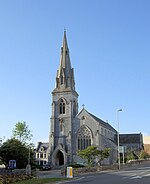Greenhill, Dorset
Beaches of DorsetDorset geography stubsGeography of Weymouth, DorsetJurassic CoastUse British English from June 2017

Greenhill is a suburb to the northeast of Weymouth in Dorset, England, with a sand and shingle beach. The A353 road, locally known as Greenhill, runs parallel and close to the beach. To the northeast it becomes Preston Road, leading to the village of Preston. Also to the northeast along the coast are Furzy Cliff, Jordan Hill, and Bowleaze Cove. To the southwest is the sandy Weymouth Beach and seaward is Weymouth Bay. The suburb contains Greenhill Gardens.
Excerpt from the Wikipedia article Greenhill, Dorset (License: CC BY-SA 3.0, Authors, Images).Greenhill, Dorset
Esplanade,
Geographical coordinates (GPS) Address Nearby Places Show on map
Geographical coordinates (GPS)
| Latitude | Longitude |
|---|---|
| N 50.62064 ° | E -2.44805 ° |
Address
Esplanade
Esplanade
DT4 7RN , Melcombe Regis
England, United Kingdom
Open on Google Maps









